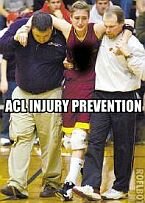Concussion Guidelines
ATTENTION PARENTS AND ATHLETES!
GREAT CONCUSSION APPPRINT OUR 2 PAGE CONCUSSION GUIDE BY CLICKING HERE!
Free Online Sports Concussion Presentation by the CDC
CLICK HERE TO VIEW THE 60 MINUTES SEGMENT ON CONCUSSION (10/11/09)
WATCH THIS YOUTUBE VIDEO ON THE "FENCING RESPONSE"
CONCUSSION EVALUATION FORM FOR COACHES: This form is for use by coaches to assess the athlete for a concussion.
Girls Are Often Neglected Victims of Concussions - N.Y. Times, October 2, 2007
3rd International Conference on Concussions: 2008
Concussions Exact Toll on Football Players Long After They Retire
Neuropsychological Testing in Sports Concussion
Youth Concussion Program - Ten Steps
"According to the Centers for Disease Control and Prevention, 20 percent of the brain injuries that occur yearly in the U.S. can be attributred to athletics. That is more than 300,000 concussions! High school, college and amateur athletes receive most of these injuries, because thee are so many more of these players than there are pros." 1 There are an estimated 62,800 concussions annually among high school students nationwide. 2 Data from the NCAA Injury Surveillance System for the perior 1994-1996 estimated that more than 1500 concussions occur annually in college football. 3
"'This is a major public health issue that's been geven short shrift,' says Michael W. Collins of the Henry Ford Hospital in Detroit. 'It's underrecognized, underdiagnosed and misdiagnosed. It's happening with alarming frequency at the high school, college, and professional levels." 1
"A single blow to the head can cause a whole range of symptoms, from problems with balance and coordination to impaired decision making, failing memory and personality changes. Unless the injury is severe, patients generally recover with time. But most athletes return to games or practices far to soon. A second blow before a consussion is fully healed has a far greater chance of imposing more serious, long-lasting harm." 1
393 college football players were studied and about one in three had suffered a concussion and one in five had suffered two or more. Those who had suffered two or more were significantly more likely to report continuing problems with headaches, sleep and concentration, and they scored significantly worse on tests of the ability to learn words, to think quickly and to handle complex tasks. 2
Players who had learning disorders fared even worse if they had two or more concussions, suggesting that the disorders make the brain especially vulnerable to jarring head injuries. 2
Another study in JAMA reported that amateur soccer players scored lower on tests of memory and planning than other amateur athletes did, and that repeated blows to the head may be the culprit. 2
WHAT IS A CONCUSSION?
"The definition of concussion is a post-traumatic impairment of neural status. While the loss of consciousness and amnesia may have been viewed as the primary components of this injury and have formed the basis for most grading scales, some of the mild concussions, the so called 'bell-rung' or 'ding,' with no resulting loss of consciousness or post-traumatic amnesia, may go unrecognized by coaches, athletic trainers, fellow players or team physicians." 3
The brain sits inside a bony encasement called the skull. A collision, abrupt stop or whiplash motion can cause the brain to slam up against the inside of the skull like a pinball. Most of the time the brain tissue itself is not damaged (except in the worst cases), but a devastating cascade of chemical reactions is unleashed. 1
This slamming of the brain causes the brain cells (neurons) to fire off sending the brain into a panic almost like a brief seizure. This sinister wave of extreme electrical activity spreads across the brain telling the neurons to keep firing. This excess firing clogs the mitochondria (energy producing part of the neuron) and prevents it from doing its job. This is a big problem because the neurons are attempting to regain a normal state so that they can fire again and this scramble consumes a lot of energy. So just when more energy is needed, the mitochondria cannot produce it. 1
To compound the problem, the brain's blood vessels constrict, preventing the blood from carrying glucose ("fuel")and thereby causing an energy crisis. This can kill brain cells and result in permanent brain damage. 1
To make matters even worse, extra sodium enters the neurons causing them to swell and push against the skull. If the swelling is severe, the brain can crush itself against the skull causing more cell to die. 1
These chemical reactions peak rapidly, but it takes a long time to settle the brain back to normal. Once the brain can meet the high energy demand and does return to normal it goes into a state of metabolic depression, i.e. exhaustion. The more severe the concussion, the longer this chemical cascade can continue. 1 "If a second concussion interrupts the brain's quest for equilibrium...a new cascade starts on top of the first one. The resulting damage is not just additive but multiplicative." 1
DANGEROUS SPORTS
The threat of concussion varies from sport to sport, but a 1999 study tracked varsity athletes from 235 Iowa high schools. The authors found football accounted for the most brain injuries, followed by wrestling, soccer and basketball. For all the sports except volleyball, the rate of concussion was up to 14 times greater during games than practice. Athletes "who sustained more than one concussion tended to get their second in the same season as the first, rather than later - perhaps because of the impairment from the first concussion." 1
CONCUSSION RECOGNITION AND MANAGEMENT
A concussion may or may not involve loss of consciousness. IF IN DOUBT IT IS A CONCUSSION! The following is a list of symptoms of concussion: From CONCUSSION EVALUATION FORM FOR COACHES
| Loss of consciousness | Seizure or convulsion | Amnesia | Headache |
| Pressure in head | Neck pain | Nausea or vomiting | Ringing in the ears |
| Dizziness | Blurred vision | Balance problems | Sensitivity to light |
| Sensitivity to noise | Feeling slowed down | Feeling like in a fog | Don't feel right |
| Difficulty concentrating | Difficulty remembering | Fatigue or low energy | Confusion |
| Drowsiness | More emotional | Irritability | Sadness |
| Nervous | Anxiety |
RETURN TO PLAY (from Impact Concussion Management Software Return To Play Guidelines
1. Removal from contest following and signs/symptoms of concussion.
2. No return to play in current game
3. Medical evaluation following injury
a. Rule out more serious intracranial pathology
b. Neuropsychological Testing considered cornerstone or proper post-injury assessment
4. Stepwise return to play
a. No activity and rest until asymptomatic
b. Light aerobic exercise
c. Sport-specific training
d. Non-contact drills
e. Full-contact drills
f. Game Play
The 2009-2010 NCAA Sports Medicine Handbook, pp.54-55, states:
It is essential that no athlete be allowed to return to participation when any symptoms, including mild headache, persist. It has also been recommended that for any injury that involves significant symptoms, long duration of symptoms or difficulties with memory function (either retrograde or antegrade), not be allowed to return to play during the same day of competition. The duration of time that an athlete should be kept out of physical activity is unclear, and in most instances, individualized return-to-play decisions should be made. These decisions will often depend on the clinical symptoms, previous history of concussion and severity of previous concussions. Additional factors include the sport, position, age, support system for the athlete and the overall readiness of the athlete to return to sport.
Once an athlete is completely asymptomatic, the return-to-play progression should occur in a stepwise fashion with gradual increments in physical exertion and risk of contact. After a period of remaining asymptomatic, the first step is an exertional challenge in which the athlete exercises for 15 to 20 minutes in an activity such as biking or running in which he/she increases his/her heartrate and breaks a sweat. If he/she does not experience any symptoms, this can be followed by a steady increase in exertion, followed by return-to-sport- specific activities that do not put the athlete at risk for contact. Examples include dribbling a ball or shooting, stickwork or passing, or other agilities. This allows the athlete to return to the practice setting, albeit in a limited role. Finally, the athlete can be progressed to practice activities with limited contact and finally full contact. How quickly one moves through this progression remains controversial.
Three recent studies show the importance of proper assessement of the concussed athlete and support the removal of ANY concussed player from a practice or game.
Zemper ED: Two-year prospective study of relative risk of a second cerebral concussion. Am J Phys Med Rehabil 2003;82(9):653-659.
This study reported that the relative risk for patients who had a history of concussion was almost 6 times greater than those who did not.
Guskiewicz KM, et al: Cumulative effects associated with recurrent concussion in collegiate football players: the NCAA Concussion Study. JAMA 2003;290(19):2549-2555.
The players who reported a history of three or more concussions were three times more likely to have another concussion than players without a history of concussion. Also, a history of multiple concussions was associated with slowed recovery.
McCrea M, et al: Acuter effects and recovery time following concussion in collegiate football players: the NCAA Concussion Study. JAMA 2003;290(19):2556-2563.
Players with concussions had more severy symptoms, cognitive impairment, and balance problems immediately after sustaining a concussion. Symptoms gradually resolved by day 7.
PREVENTION
1. Learn proper tackling techniques in football. NO SPEARING, i.e. LEADING WITH THE HEAD!
2. Perform proper strength and conditioning, especially neck strengthening exercises.
3. Provide and properly fit equipment. Proper equipment maintenance is critical.
4. Remind all involved in sports that that they should expect an unconscious athlete to have a cervical spine injury until proven otherwise.
5. Learn proper helmut removal and transportation techniques.
1 Shulman, Polly. "Blowing the Whistle on Concussions." ScientificAmerican Presents, 11(3):44-51, Fall, 2000.
2 A collection of articles on brain injury in high school, college and professional athletes can be found in the Journal of the American Medical Association, 22(22); September 8, 1999.
3 NCAA Sports Medicine Handbook 2009-2010
MORE INFORMATION:
NFL: Dodging the Concussion Issue
Concussion IMPACT
Mouthguards and Concussion
Sports Legacy
Summary and Agreement Statement of the Third International Conference on Concussion 2008
Donating His Brain - Ted Johnson, Linebacker
Inter-Association Task Force for Appropriate Care of the Spine-Injured Athlete
Can Contact Sports Lower Your Intelligence?
Making Headway
Sports Imperative: Protecting Your Brain
|
The Ultimate Nutritional Lie Detector Test LEARN MORE 
|
Kettlebell Rehab

Click Here
To See How Kettlebells will transform your body!
Vortex Rehab

Click Here
To See How This
Revolutionary Machine
Can Help You!
Partner / Support

Loans up to 3 months - fast cash advances for up to 90 days and up to $5,000!



















